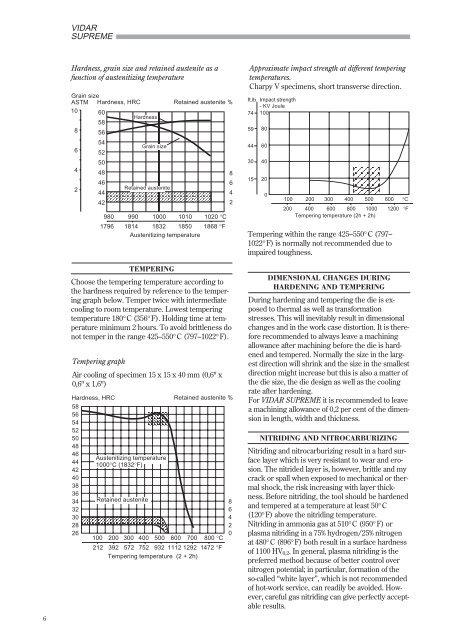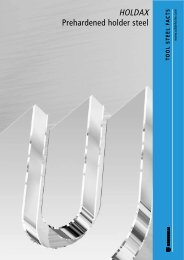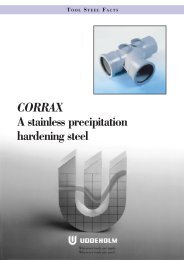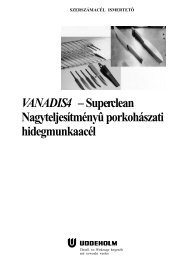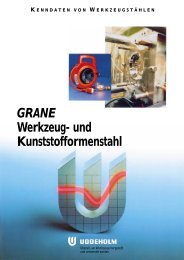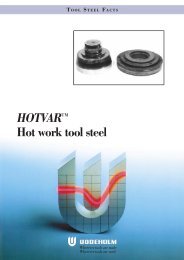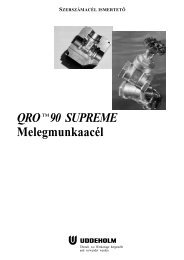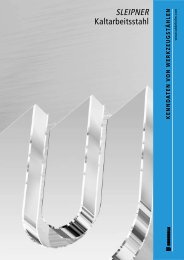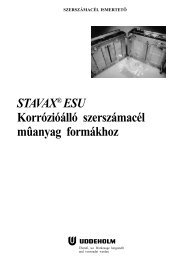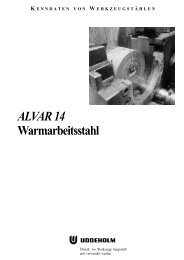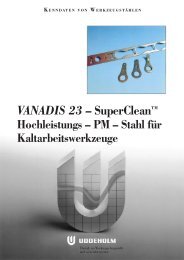VIDAR™ SUPREME Hot work tool steel - Uddeholm
VIDAR™ SUPREME Hot work tool steel - Uddeholm
VIDAR™ SUPREME Hot work tool steel - Uddeholm
Create successful ePaper yourself
Turn your PDF publications into a flip-book with our unique Google optimized e-Paper software.
6<br />
VIDAR<br />
<strong>SUPREME</strong><br />
Hardness, grain size and retained austenite as a<br />
function of austenitizing temperature<br />
Grain size<br />
ASTM Hardness, HRC<br />
Retained austenite %<br />
10 60<br />
58<br />
Hardness<br />
8 56<br />
6<br />
54<br />
52<br />
50<br />
Grain size<br />
4<br />
48<br />
8<br />
2<br />
46<br />
44<br />
Retained austenite<br />
6<br />
4<br />
42<br />
2<br />
Tempering graph<br />
Air cooling of specimen 15 x 15 x 40 mm (0,6" x<br />
0,6" x 1,6")<br />
Hardness, HRC Retained austenite %<br />
58<br />
56<br />
54<br />
52<br />
50<br />
48<br />
46<br />
44<br />
42<br />
40<br />
38<br />
36<br />
34<br />
32<br />
30<br />
28<br />
26<br />
980 990 1000 1010 1020 °C<br />
1796 1814 1832 1850 1868 °F<br />
Austenitizing temperature<br />
TEMPERING<br />
Choose the tempering temperature according to<br />
the hardness required by reference to the tempering<br />
graph below. Temper twice with intermediate<br />
cooling to room temperature. Lowest tempering<br />
temperature 180°C (356°F). Holding time at temperature<br />
minimum 2 hours. To avoid brittleness do<br />
not temper in the range 425–550°C (797–1022°F).<br />
Austenitizing temperature<br />
1000°C (1832°F)<br />
Retained austenite<br />
100 200 300 400 500 600 700 800 °C<br />
212 392 572 752 932 1112 1292 1472 °F<br />
Tempering temperature (2 + 2h)<br />
8<br />
6<br />
4<br />
2<br />
0<br />
Approximate impact strength at different tempering<br />
temperatures.<br />
Charpy V specimens, short transverse direction.<br />
ft.lb.<br />
74<br />
59<br />
44<br />
30<br />
15<br />
Impact strength<br />
- KV Joule<br />
100<br />
80<br />
60<br />
40<br />
20<br />
0<br />
100 200 300 400 500 600 °C<br />
200 400 600 800 1000 1200 °F<br />
Tempering temperature (2h + 2h)<br />
Tempering within the range 425–550°C (797–<br />
1022°F) is normally not recommended due to<br />
impaired toughness.<br />
DIMENSIONAL CHANGES DURING<br />
HARDENING AND TEMPERING<br />
During hardening and tempering the die is exposed<br />
to thermal as well as transformation<br />
stresses. This will inevitably result in dimensional<br />
changes and in the <strong>work</strong> case distortion. It is therefore<br />
recommended to always leave a machining<br />
allowance after machining before the die is hardened<br />
and tempered. Normally the size in the largest<br />
direction will shrink and the size in the smallest<br />
direction might increase but this is also a matter of<br />
the die size, the die design as well as the cooling<br />
rate after hardening.<br />
For VIDAR <strong>SUPREME</strong> it is recommended to leave<br />
a machining allowance of 0,2 per cent of the dimension<br />
in length, width and thickness.<br />
NITRIDING AND NITROCARBURIZING<br />
Nitriding and nitrocarburizing result in a hard surface<br />
layer which is very resistant to wear and erosion.<br />
The nitrided layer is, however, brittle and my<br />
crack or spall when exposed to mechanical or thermal<br />
shock, the risk increasing with layer thickness.<br />
Before nitriding, the <strong>tool</strong> should be hardened<br />
and tempered at a temperature at least 50°C<br />
(120°F) above the nitriding temperature.<br />
Nitriding in ammonia gas at 510°C (950°F) or<br />
plasma nitriding in a 75% hydrogen/25% nitrogen<br />
at 480°C (896°F) both result in a surface hardness<br />
of 1100 HV0,2. In general, plasma nitriding is the<br />
preferred method because of better control over<br />
nitrogen potential; in particular, formation of the<br />
so-called “white layer”, which is not recommended<br />
of hot-<strong>work</strong> service, can readily be avoided. However,<br />
careful gas nitriding can give perfectly acceptable<br />
results.


